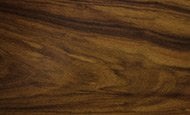Imbuia
PHOTO |
 |
| DESCRIPTION | Imbuia's color ranges from a yellowish tone or olive all the way to chocolate brown. The sapwood is in contrast to the heartwood because it tends be be grayish in color. This is a lustrous wood that features a fine texture. The grain ranges between straight and curly or wavy. |
| COUNTRY OF ORIGIN |
South America (Brazil) |
| BOTANICAL NAME | Phoebe porosa |
| OTHER NAMES | Canella Imbuia, Embuia, Embuya, Imbuya |
| MECHANICAL PROPERTIES | This wood has janka hardness of 950 |
| WORKING PROPERTIES | The wood of imbuia saws and machines satisfactorily. It also takes stains and finishes quite well. |
| DURABILITY | This lumber is quite hard and dense. Imbuia is commonly noted for its resistance to marring, denting, and wear. Its also known for its resistance to decay. |
| SEASONING | Imbuia is rated as easy to air-season with a slight tendency to check and with moderate warping; drying was uniformly rapid. |
| USES | Outdoor Decking, flooring, cogs and shafts, heavy construction, barge and dock fenders, railroad crossties, pulp mill equipment, tool handles, bearings, turnery. A substitute for lignum vitae. |
| COMMENTS | Imbuia is one of the most important commercial species in Brazil |
Imbuia Lumber Prices
> All Prices Are Subject To Change Without Notice <
